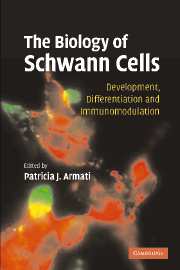Book contents
- Frontmatter
- Contents
- Preface
- Contributors
- 1 Introduction to the Schwann cell
- 2 Early events in Schwann cell development
- 3 The molecular organisation of myelinating Schwann cells
- 4 The role of the extracellular matrix in Schwann cell development and myelination
- 5 The biology of perisynaptic (terminal) Schwann cells
- 6 Cytokine and chemokine interactions with Schwann cells: the neuroimmunology of Schwann cells
- 7 Schwann cells as immunomodulatory cells
- 8 Mutations in Schwann cell genes causing inherited neuropathies
- 9 Guillain–Barré syndrome and the Schwann cell
- 10 Chronic idiopathic demyelinating polyneuropathy and Schwann cells
- References
- Index
- Plate section
3 - The molecular organisation of myelinating Schwann cells
Published online by Cambridge University Press: 13 August 2009
- Frontmatter
- Contents
- Preface
- Contributors
- 1 Introduction to the Schwann cell
- 2 Early events in Schwann cell development
- 3 The molecular organisation of myelinating Schwann cells
- 4 The role of the extracellular matrix in Schwann cell development and myelination
- 5 The biology of perisynaptic (terminal) Schwann cells
- 6 Cytokine and chemokine interactions with Schwann cells: the neuroimmunology of Schwann cells
- 7 Schwann cells as immunomodulatory cells
- 8 Mutations in Schwann cell genes causing inherited neuropathies
- 9 Guillain–Barré syndrome and the Schwann cell
- 10 Chronic idiopathic demyelinating polyneuropathy and Schwann cells
- References
- Index
- Plate section
Summary
INTRODUCTION
Myelinating Schwann cells have unique structural and molecular adaptations that promote saltatory conduction. The myelin lamellae itself can be divided into several domains – compact myelin, regions of specialised junctions between the layers of the myelin lamellae (‘non-compact myelin’), the abaxonal/outer membrane, and the adaxonal/inner membranes, and the regions at the node, paranode, and juxtaparanode. P0, myelin basic protein (MBP), and peripheral myelin protein 22 kD (PMP22) are the main proteins of compact myelin. Incisures and paranodes contain the molecular components of adherens junctions, tight junctions and gap junctions. Nodal microvilli contain cytoskeletal components, dystroglycan, syndecan-3 and -4, and possibly cell adhesion molecules (CAMs) that may interact with CAMs on the nodal axolemma (Nr-CAM and neurofascin 186 kD; NF186) to cluster voltage-gated Na+ (NaV) channels. The nodal axolemma also contains voltage-gated K+ channels (KCNQ2 and Kv3.1b). NaV channel α subunits are directly linked to the spectrin cytoskeleton by ankyrinG, and indirectly by their β subunits. The paranodal glial loops contain NF155, which interacts directly with contactin, and indirectly with contactin/Caspr heterodimers, forming septate-like junctions. In the juxtaparanodal region, connexin29 (Cx29) may form hemi-channels on the adaxonal Schwann cell membrane; these directly appose a complex of Kv1.1/Kv1.2 K+ channels and Caspr2 on the axonal membrane; trans-interacting, transiently expressed axonal surface glycoprotein-1 (TAG-1) dimers may join the two apposed membranes. Kv1.1, Kv1.2 and Caspr2 each have a PDZ binding site and may interact with the same PDZ protein.
- Type
- Chapter
- Information
- The Biology of Schwann CellsDevelopment, Differentiation and Immunomodulation, pp. 37 - 54Publisher: Cambridge University PressPrint publication year: 2007
- 4
- Cited by



